radiator SKODA YETI 2010 1.G / 5L Owner's Manual
[x] Cancel search | Manufacturer: SKODA, Model Year: 2010, Model line: YETI, Model: SKODA YETI 2010 1.G / 5LPages: 271, PDF Size: 14.71 MB
Page 16 of 271
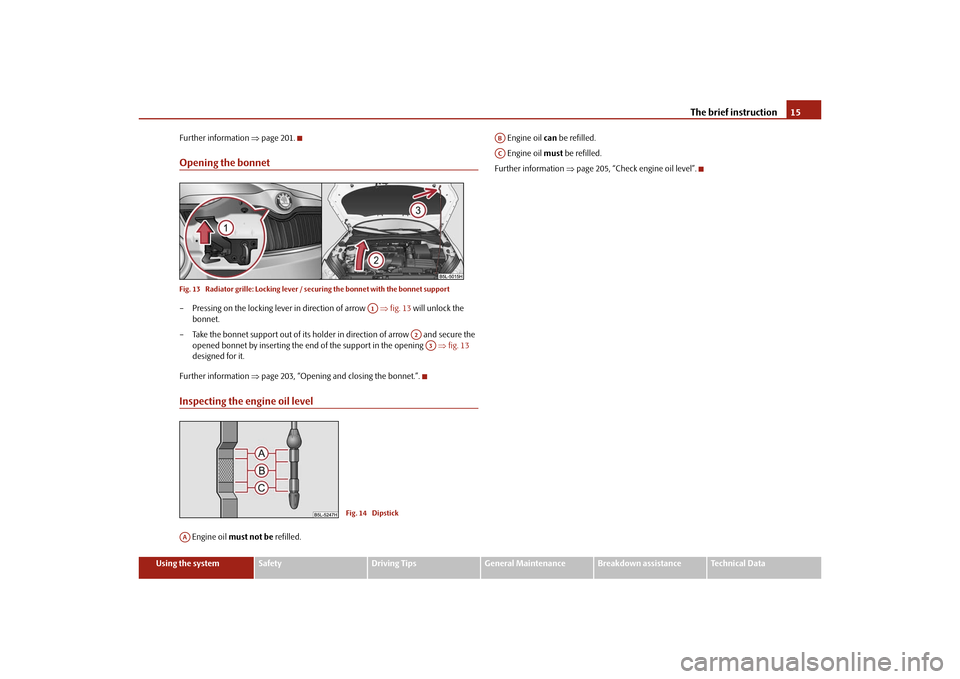
The brief instruction15
Using the system
Safety
Driving Tips
General Maintenance
Breakdown assistance
Technical Data
Further information
page 201.
Opening the bonnetFig. 13 Radiator grille: Locking lever / se curing the bonnet with the bonnet support– Pressing on the locking lever in direction of arrow fig. 13 will unlock the
bonnet.
– Take the bonnet support out of its holder in direction of arrow and secure the
opened bonnet by inserting the end of the support in the opening fig. 13
designed for it.
Further information page 203, “Opening and closing the bonnet.”.Inspecting the engine oil level Engine oil must not be refilled. Engine oil
can be refilled.
Engine oil must be refilled.
Further information page 205, “Check engine oil level”.
A1
A2A3
Fig. 14 Dipstick
AA
ABAC
s2ug.6.book Page 15 Friday, April 9, 2010 2:24 PM
Page 112 of 271
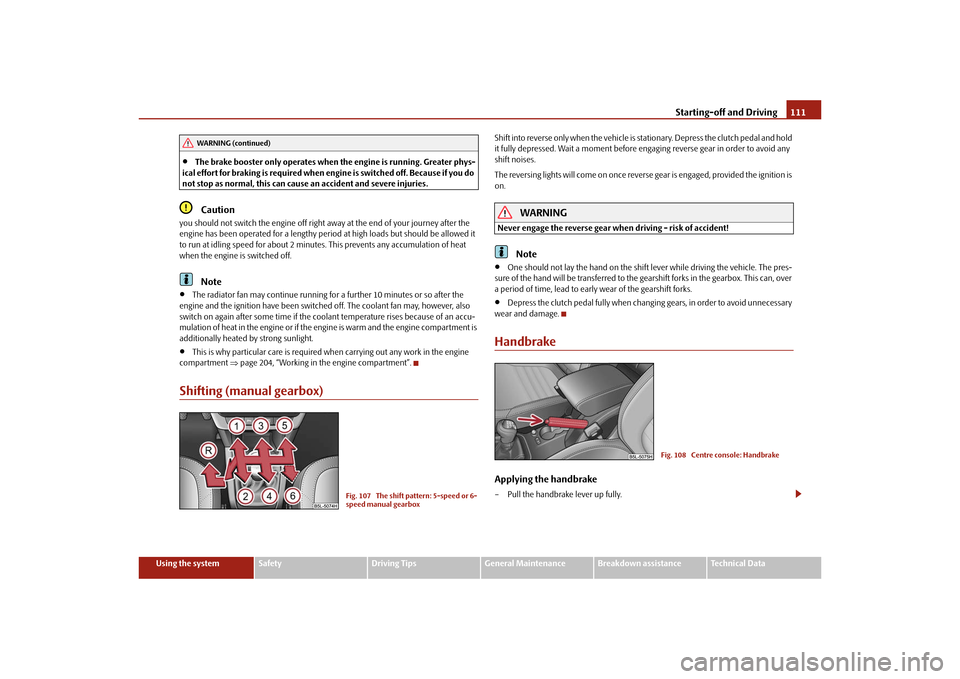
Starting-off and Driving111
Using the system
Safety
Driving Tips
General Maintenance
Breakdown assistance
Technical Data
The brake booster only operates when the engine is running. Greater phys-
ical effort for braking is required when en gine is switched off. Because if you do
not stop as normal, this can cause an accident and severe injuries.Caution
you should not switch the engine off right away at the end of your journey after the
engine has been operated for a lengthy period at high loads but should be allowed it
to run at idling speed for about 2 minutes. This prevents any accumulation of heat
when the engine is switched off.
Note
The radiator fan may continue running fo r a further 10 minutes or so after the
engine and the ignition have been switched off. The coolant fan may, however, also
switch on again after some time if the co olant temperature rises because of an accu-
mulation of heat in the engine or if the engine is warm and the engine compartment is
additionally heated by strong sunlight.
This is why particular care is required when carrying out any work in the engine
compartment page 204, “Working in the engine compartment”.
Shifting (manual gearbox)
Shift into reverse only when the vehicle is stationary. Depress the clutch pedal and hold
it fully depressed. Wait a mo ment before engaging reverse gear in order to avoid any
shift noises.
The reversing lights will come on once reverse gear is engaged, provided the ignition is
on.
WARNING
Never engage the reverse gear when driving - risk of accident!
Note
One should not lay the hand on the shift lever while driving the vehicle. The pres-
sure of the hand will be transferred to the gearshift forks in the gearbox. This can, over
a period of time, lead to early wear of the gearshift forks.
Depress the clutch pedal full y when changing gears, in order to avoid unnecessary
wear and damage.
HandbrakeApplying the handbrake– Pull the handbrake lever up fully.
WARNING (continued)
Fig. 107 The shift pattern: 5-speed or 6-
speed manual gearbox
Fig. 108 Centre console: Handbrake
s2ug.6.book Page 111 Friday, April 9, 2010 2:24 PM
Page 189 of 271
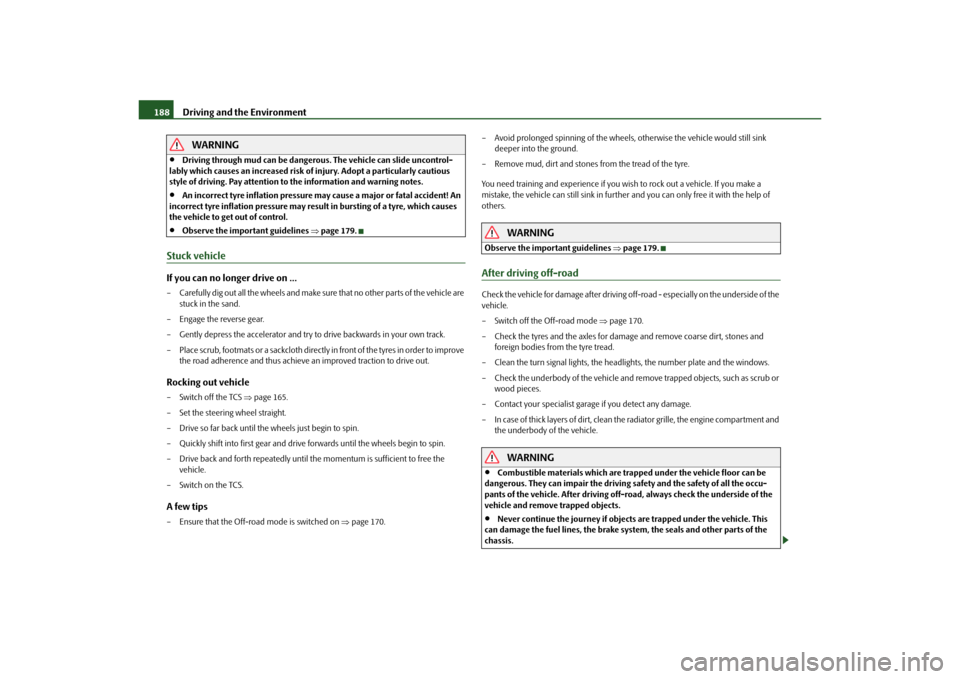
Driving and the Environment
188WARNING
Driving through mud can be dangerous. The vehicle can slide uncontrol-
lably which causes an increased risk of injury. Adopt a particularly cautious
style of driving. Pay attention to the information and warning notes.
An incorrect tyre inflation pressure may cause a major or fatal accident! An
incorrect tyre inflation pressure may result in bursting of a tyre, which causes
the vehicle to get out of control.
Observe the important guidelines page 179.
Stuck vehicleIf you can no longer drive on ...– Carefully dig out all the wheels and make sure that no other parts of the vehicle are
stuck in the sand.
– Engage the reverse gear.
– Gently depress the accelerator and try to drive backwards in your own track.
– Place scrub, footmats or a sackcloth directly in front of the tyres in order to improve
the road adherence and thus achieve an improved traction to drive out.Rocking out vehicle–Switch off the TCS page 165.
– Set the steering wheel straight.
– Drive so far back until the wheels just begin to spin.
– Quickly shift into first gear and drive forwards until the wheels begin to spin.
– Drive back and forth repeatedly until the momentum is sufficient to free the vehicle.
–Switch on the TCS.A few tips– Ensure that the Off-road mode is switched on page 170. – Avoid prolonged spinning of the wheels, otherwise the vehicle would still sink
deeper into the ground.
– Remove mud, dirt and stones from the tread of the tyre.
You need training and experience if you wish to rock out a vehicle. If you make a
mistake, the vehicle can still sink in further and you can only free it with the help of
others.
WARNING
Observe the important guidelines page 179.After driving off-roadCheck the vehicle for damage after driving off-road - especially on the underside of the
vehicle.
– Switch off the Off-road mode page 170.
– Check the tyres and the axles for damage and remove coarse dirt, stones and foreign bodies from the tyre tread.
– Clean the turn signal lights, the headlights, the number plate and the windows.
– Check the underbody of the vehicle and remove trapped objects, such as scrub or wood pieces.
– Contact your specialist gara ge if you detect any damage.
– In case of thick layers of dirt, clean the radiator grille, the engine compartment and the underbody of the vehicle.
WARNING
Combustible materials which are tra pped under the vehicle floor can be
dangerous. They can impair the driving safety and the safety of all the occu-
pants of the vehicle. After driving off-road, always check the underside of the
vehicle and remove trapped objects.
Never continue the journey if objects are trapped under the vehicle. This
can damage the fuel lines, the brake system, the seals and other parts of the
chassis.
s2ug.6.book Page 188 Friday, April 9, 2010 2:24 PM
Page 204 of 271
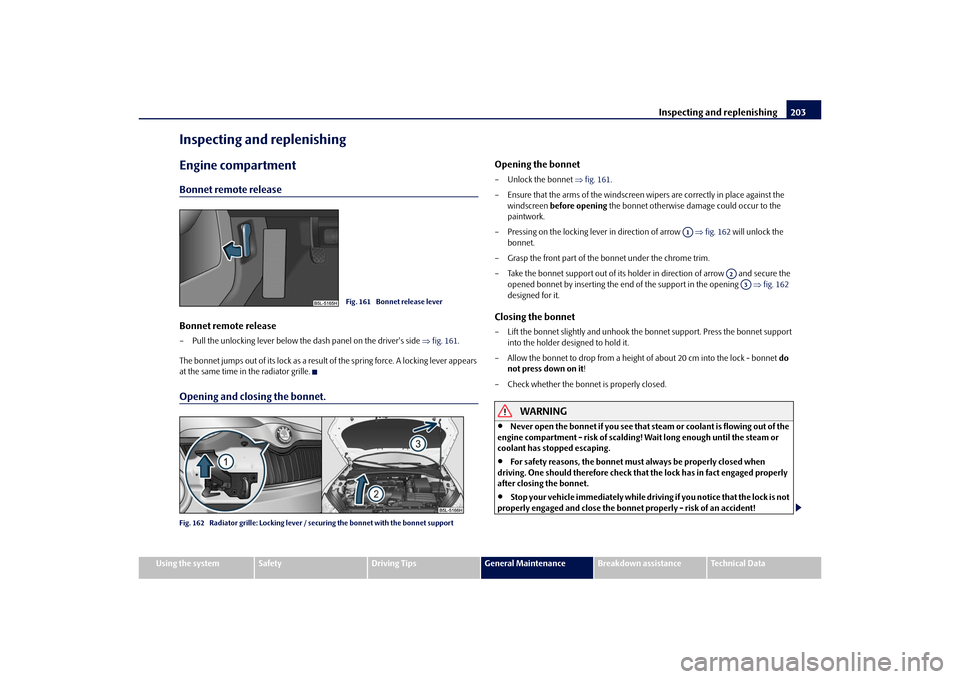
Inspecting and replenishing203
Using the system
Safety
Driving Tips
General Maintenance
Breakdown assistance
Technical Data
Inspecting and replenishingEngine compartmentBonnet remote releaseBonnet remote release– Pull the unlocking lever below the dash panel on the driver's side fig. 161 .
The bonnet jumps out of its lock as a result of the spring force. A locking lever appears
at the same time in the radiator grille.Opening and closing the bonnet.Fig. 162 Radiator grille: Locking lever / se curing the bonnet with the bonnet support
Opening the bonnet– Unlock the bonnet fig. 161 .
– Ensure that the arms of the windscreen wipers are correctly in place against the windscreen before opening the bonnet otherwise damage could occur to the
paintwork.
– Pressing on the locking lever in direction of arrow fig. 162 will unlock the
bonnet.
– Grasp the front part of the bonnet under the chrome trim.
– Take the bonnet support out of its holder in direction of arrow and secure the opened bonnet by inserting the end of the support in the opening fig. 162
designed for it.Closing the bonnet– Lift the bonnet slightly and unhook the bonnet support. Press the bonnet support
into the holder designed to hold it.
– Allow the bonnet to drop from a height of about 20 cm into the lock - bonnet do
not press down on it !
– Check whether the bonnet is properly closed.
WARNING
Never open the bonnet if you see that steam or coolant is flowing out of the
engine compartment - risk of scalding! Wait long enough until the steam or
coolant has stopped escaping.
For safety reasons, the bonnet must always be properly closed when
driving. One should therefore check that the lock has in fact engaged properly
after closing the bonnet.
Stop your vehicle immediately while driving if you notice that the lock is not
properly engaged and close the bonnet properly - risk of an accident!
Fig. 161 Bonnet release lever
A1
A2A3
s2ug.6.book Page 203 Friday, April 9, 2010 2:24 PM
Page 205 of 271
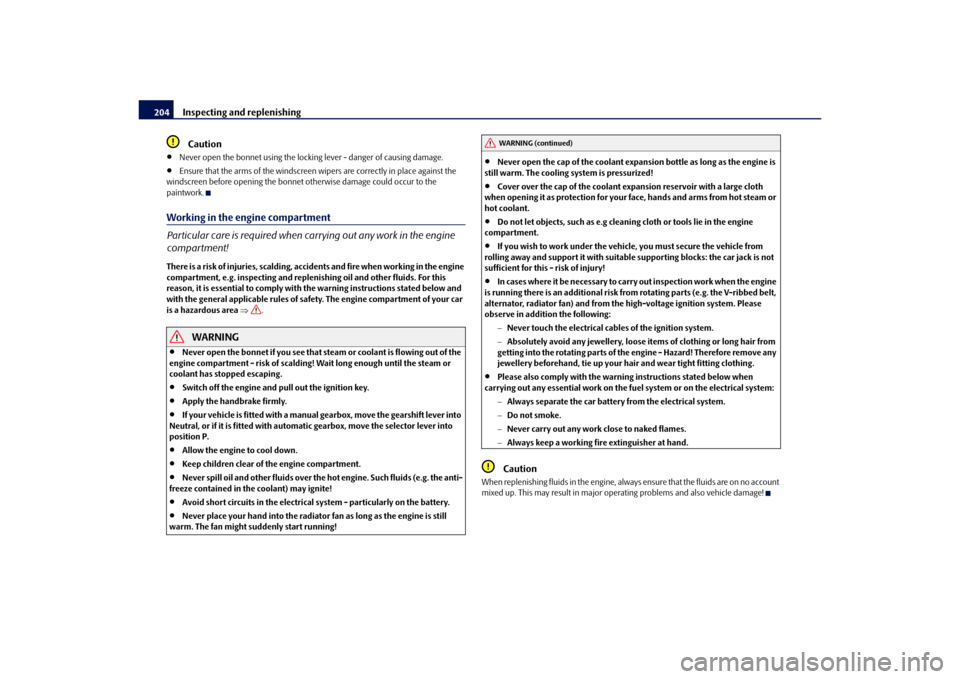
Inspecting and replenishing
204Caution
Never open the bonnet using the locking lever - danger of causing damage.
Ensure that the arms of the windscreen wipers are correctly in place against the
windscreen before opening the bonnet otherwise damage could occur to the
paintwork.
Working in the engine compartment
Particular care is required when carrying out any work in the engine
compartment!There is a risk of injuries, scalding, acci dents and fire when working in the engine
compartment, e.g. inspecting and replenishing oil and other fluids. For this
reason, it is essential to comply with the warning instructions stated below and
with the general applicable rules of safe ty. The engine compartment of your car
is a hazardous area .
WARNING
Never open the bonnet if you see that steam or coolant is flowing out of the
engine compartment - risk of scalding! Wait long enough until the steam or
coolant has stopped escaping.
Switch off the engine and pull out the ignition key.
Apply the handbrake firmly.
If your vehicle is fitted with a manual gearbox, move the gearshift lever into
Neutral, or if it is fitted with automatic gearbox, move the selector lever into
position P.
Allow the engine to cool down.
Keep children clear of the engine compartment.
Never spill oil and other fluids over the hot engine. Such fluids (e.g. the anti-
freeze contained in the coolant) may ignite!
Avoid short circuits in the electrical system - particularly on the battery.
Never place your hand into the radiator fan as long as the engine is still
warm. The fan might suddenly start running!
Never open the cap of the coolant expansion bottle as long as the engine is
still warm. The cooling system is pressurized!
Cover over the cap of the coolant expansion reservoir with a large cloth
when opening it as protection for your face, hands and arms from hot steam or
hot coolant.
Do not let objects, such as e.g cleaning cloth or tools lie in the engine
compartment.
If you wish to work under the vehicl e, you must secure the vehicle from
rolling away and support it with suitable supporting blocks: the car jack is not
sufficient for this - risk of injury!
In cases where it be necessary to carry out inspection work when the engine
is running there is an additional risk fr om rotating parts (e.g. the V-ribbed belt,
alternator, radiator fan) and from the high-voltage ignition system. Please
observe in addition the following:
Never touch the electrical cabl es of the ignition system.
Absolutely avoid any jewellery, loose it ems of clothing or long hair from
getting into the rotating parts of the engine - Hazard! Therefore remove any
jewellery beforehand, tie up your hair and wear tight fitting clothing.
Please also comply with the warnin g instructions stated below when
carrying out any essential work on the fuel system or on th e electrical system:
Always separate the car battery from the electrical system.
Do not smoke.
Never carry out any work close to naked flames.
Always keep a working fire extinguisher at hand.Caution
When replenishing fluids in the engine, always ensure that the fluids are on no account
mixed up. This may result in major oper ating problems and also vehicle damage!
WARNING (continued)
s2ug.6.book Page 204 Friday, April 9, 2010 2:24 PM
Page 210 of 271
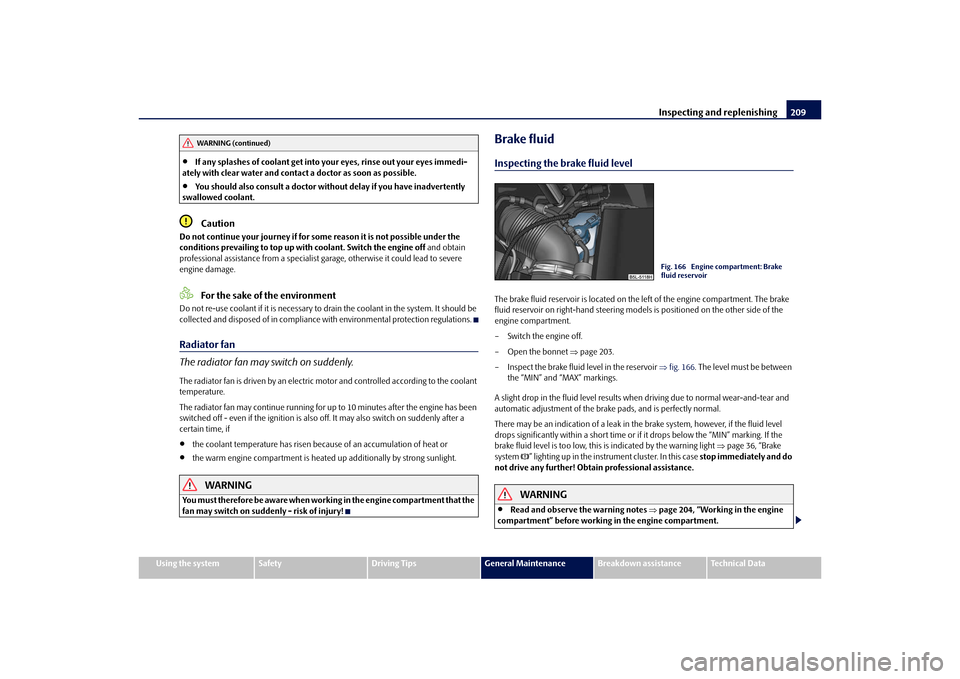
Inspecting and replenishing209
Using the system
Safety
Driving Tips
General Maintenance
Breakdown assistance
Technical Data
If any splashes of coolant get into yo ur eyes, rinse out your eyes immedi-
ately with clear water and contact a doctor as soon as possible.
You should also consult a doctor without delay if you have inadvertently
swallowed coolant.Caution
Do not continue your journey if for some reason it is not possible under the
conditions prevailing to top up with coolant. Switch the engine off and obtain
professional assistance from a specialist garage, otherwise it could lead to severe
engine damage.
For the sake of the environment
Do not re-use coolant if it is necessary to drain the coolant in the system. It should be
collected and disposed of in compliance with environmental protection regulations.Radiator fan
The radiator fan may switch on suddenly.The radiator fan is driven by an electric motor and controlled according to the coolant
temperature.
The radiator fan may continue running for up to 10 minutes after the engine has been
switched off - even if the igni tion is also off. It may also switch on suddenly after a
certain time, if
the coolant temperature has risen beca use of an accumulation of heat or
the warm engine compartment is heated up additionally by strong sunlight.
WARNING
You must therefore be aware when workin g in the engine compartment that the
fan may switch on suddenly - risk of injury!
Brake fluidInspecting the brake fluid levelThe brake fluid reservoir is located on the left of the engine compartment. The brake
fluid reservoir on right-hand steering models is positioned on the other side of the
engine compartment.
– Switch the engine off.
– Open the bonnet page 203.
– Inspect the brake fluid level in the reservoir fig. 166 . The level must be between
the “MIN” and “MAX” markings.
A slight drop in the fluid level results when driving due to normal wear-and-tear and
automatic adjustment of the brak e pads, and is perfectly normal.
There may be an indication of a leak in the brake system, however, if the fluid level
drops significantly within a short time or if it drops below the “MIN” marking. If the
brake fluid level is too low, this is indicated by the warning light page 36, “Brake
system ” lighting up in the instru ment cluster. In this case stop immediately and do
not drive any further! Obtain professional assistance.
WARNING
Read and observe the warning notes page 204, “Working in the engine
compartment” before working in the engine compartment.
WARNING (continued)
Fig. 166 Engine compartment: Brake
fluid reservoir
s2ug.6.book Page 209 Friday, April 9, 2010 2:24 PM
Page 216 of 271
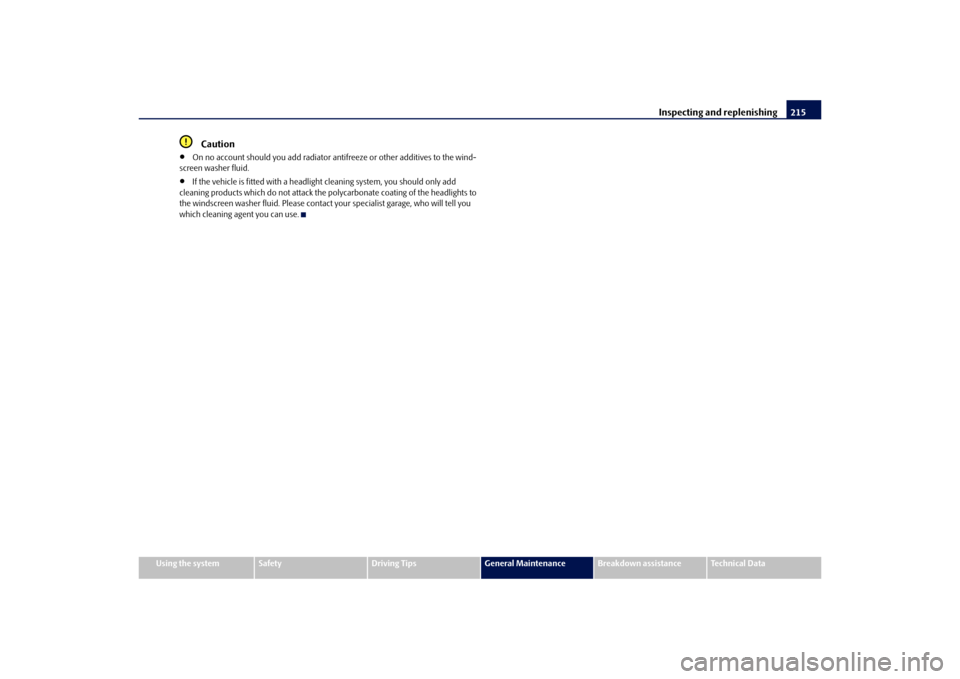
Inspecting and replenishing215
Using the system
Safety
Driving Tips
General Maintenance
Breakdown assistance
Technical Data
Caution
On no account should you add radiator an tifreeze or other additives to the wind-
screen washer fluid.
If the vehicle is fitted with a headligh t cleaning system, you should only add
cleaning products which do no t attack the polycarbonate coating of the headlights to
the windscreen washer fluid. Please contac t your specialist garage, who will tell you
which cleaning agent you can use.
s2ug.6.book Page 215 Friday, April 9, 2010 2:24 PM
Page 236 of 271
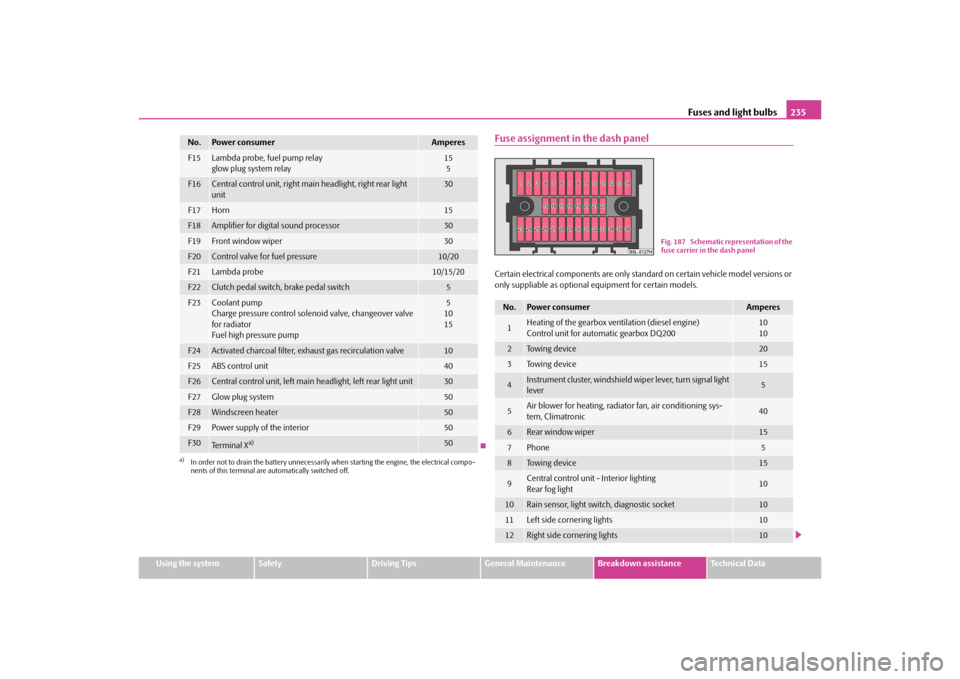
Fuses and light bulbs235
Using the system
Safety
Driving Tips
General Maintenance
Breakdown assistance
Technical Data
Fuse assignment in the dash panelCertain electrical components are only stan dard on certain vehicle model versions or
only suppliable as optional equipment for certain models.
F15
Lambda probe, fuel pump relay
glow plug system relay
15
5
F16
Central control unit, right main headlight, right rear light
unit
30
F17
Horn
15
F18
Amplifier for digital sound processor
30
F19
Front window wiper
30
F20
Control valve for fuel pressure
10/20
F21
Lambda probe
10/15/20
F22
Clutch pedal switch, brake pedal switch
5
F23
Coolant pump
Charge pressure control solenoid valve, changeover valve
for radiator
Fuel high pressure pump
5
10
15
F24
Activated charcoal filter, ex haust gas recirculation valve
10
F25
ABS control unit
40
F26
Central control unit, left main headlight, left rear light unit
30
F27
Glow plug system
50
F28
Windscreen heater
50
F29
Power supply of the interior
50
F30
Te r m i n a l X
a)
50
a)In order not to drain the battery unnecessarily wh en starting the engine, the electrical compo-
nents of this terminal are automatically switched off.No.
Power consumer
Amperes
No.
Power consumer
Amperes
1
Heating of the gearbox ventilation (diesel engine)
Control unit for automatic gearbox DQ200
10
10
2
To w i n g d e v i c e
20
3
To w i n g d e v i c e
15
4
Instrument cluster, windshield wiper lever, turn signal light
lever
5
5
Air blower for heating, radiat or fan, air conditioning sys-
tem, Climatronic
40
6
Rear window wiper
15
7
Phone
5
8
To w i n g d e v i c e
15
9
Central control unit - Interior lighting
Rear fog light
10
10
Rain sensor, light switch, diagnostic socket
10
11
Left side cornering lights
10
12
Right side cornering lights
10
Fig. 187 Schematic representation of the
fuse carrier in the dash panel
s2ug.6.book Page 235 Friday, April 9, 2010 2:24 PM
Page 264 of 271
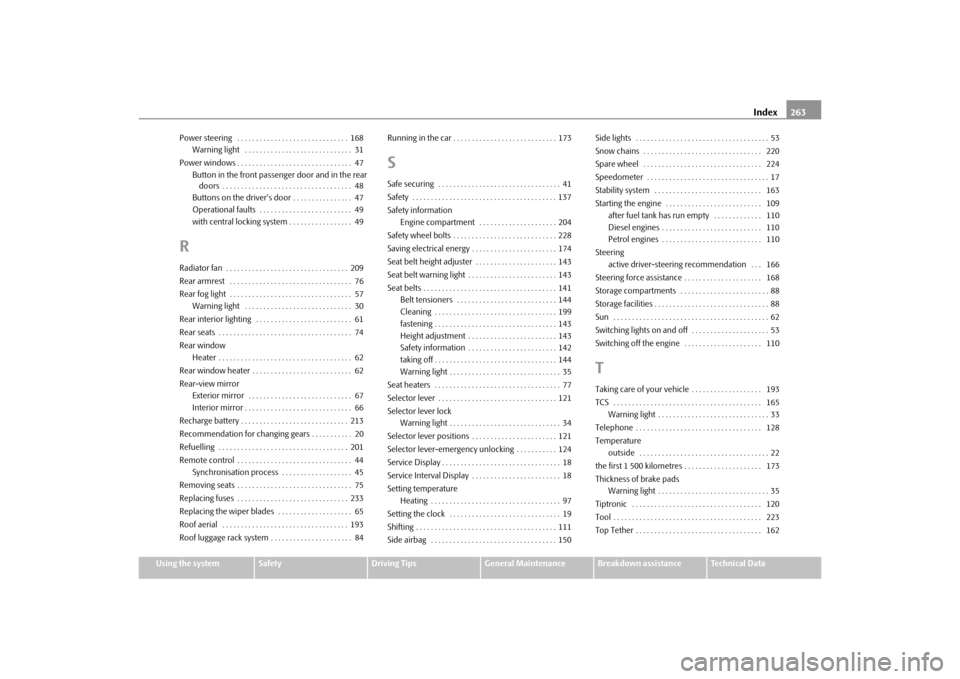
Index263
Using the system
Safety
Driving Tips
General Maintenance
Breakdown assistance
Technical Data
Power steering . . . . . . . . . . . . . . . . . . . . . . . . . . . . . . 168
Warning light . . . . . . . . . . . . . . . . . . . . . . . . . . . . . 31
Power windows . . . . . . . . . . . . . . . . . . . . . . . . . . . . . . . 47 Button in the front passenger door and in the rear doors . . . . . . . . . . . . . . . . . . . . . . . . . . . . . . . . . . . 48
Buttons on the driver's door . . . . . . . . . . . . . . . . 47
Operational faults . . . . . . . . . . . . . . . . . . . . . . . . . 49
with central locking system . . . . . . . . . . . . . . . . . 49
RRadiator fan . . . . . . . . . . . . . . . . . . . . . . . . . . . . . . . . . 209
Rear armrest . . . . . . . . . . . . . . . . . . . . . . . . . . . . . . . . . 76
Rear fog light . . . . . . . . . . . . . . . . . . . . . . . . . . . . . . . . . 57 Warning light . . . . . . . . . . . . . . . . . . . . . . . . . . . . . 30
Rear interior lighting . . . . . . . . . . . . . . . . . . . . . . . . . . 61
Rear seats . . . . . . . . . . . . . . . . . . . . . . . . . . . . . . . . . . . . 74
Rear window Heater . . . . . . . . . . . . . . . . . . . . . . . . . . . . . . . . . . . . 62
Rear window heater . . . . . . . . . . . . . . . . . . . . . . . . . . . 62
Rear-view mirror Exterior mirror . . . . . . . . . . . . . . . . . . . . . . . . . . . . 67
Interior mirror . . . . . . . . . . . . . . . . . . . . . . . . . . . . . 66
Recharge battery . . . . . . . . . . . . . . . . . . . . . . . . . . . . . 213
Recommendation for changing gears . . . . . . . . . . . 20
Refuelling . . . . . . . . . . . . . . . . . . . . . . . . . . . . . . . . . . . 201
Remote control . . . . . . . . . . . . . . . . . . . . . . . . . . . . . . . 44 Synchronisation process . . . . . . . . . . . . . . . . . . . 45
Removing seats . . . . . . . . . . . . . . . . . . . . . . . . . . . . . . . 75
Replacing fuses . . . . . . . . . . . . . . . . . . . . . . . . . . . . . . 233
Replacing the wiper blades . . . . . . . . . . . . . . . . . . . . 65
Roof aerial . . . . . . . . . . . . . . . . . . . . . . . . . . . . . . . . . . 193
Roof luggage rack system . . . . . . . . . . . . . . . . . . . . . . 84 Running in the car . . . . . . . . . . . . . . . . . . . . . . . . . . . . 173
SSafe securing . . . . . . . . . . . . . . . . . . . . . . . . . . . . . . . . . 41
Safety . . . . . . . . . . . . . . . . . . . . . . . . . . . . . . . . . . . . . . . 137
Safety information
Engine compartment . . . . . . . . . . . . . . . . . . . . . 204
Safety wheel bolts . . . . . . . . . . . . . . . . . . . . . . . . . . . . 228
Saving electrical energy . . . . . . . . . . . . . . . . . . . . . . . 174
Seat belt height adjuster . . . . . . . . . . . . . . . . . . . . . . 143
Seat belt warning light . . . . . . . . . . . . . . . . . . . . . . . . 143
Seat belts . . . . . . . . . . . . . . . . . . . . . . . . . . . . . . . . . . . . 141 Belt tensioners . . . . . . . . . . . . . . . . . . . . . . . . . . . 144
Cleaning . . . . . . . . . . . . . . . . . . . . . . . . . . . . . . . . . 199
fastening . . . . . . . . . . . . . . . . . . . . . . . . . . . . . . . . . 143
Height adjustment . . . . . . . . . . . . . . . . . . . . . . . . 143
Safety information . . . . . . . . . . . . . . . . . . . . . . . . 142
taking off . . . . . . . . . . . . . . . . . . . . . . . . . . . . . . . . . 144
Warning light . . . . . . . . . . . . . . . . . . . . . . . . . . . . . . 35
Seat heaters . . . . . . . . . . . . . . . . . . . . . . . . . . . . . . . . . . 77
Selector lever . . . . . . . . . . . . . . . . . . . . . . . . . . . . . . . . 121
Selector lever lock Warning light . . . . . . . . . . . . . . . . . . . . . . . . . . . . . . 34
Selector lever positions . . . . . . . . . . . . . . . . . . . . . . . 121
Selector lever-emergency unlocking . . . . . . . . . . . 124
Service Display . . . . . . . . . . . . . . . . . . . . . . . . . . . . . . . . 18
Service Interval Display . . . . . . . . . . . . . . . . . . . . . . . . 18
Setting temperature Heating . . . . . . . . . . . . . . . . . . . . . . . . . . . . . . . . . . . 97
Setting the clock . . . . . . . . . . . . . . . . . . . . . . . . . . . . . . 19
Shifting . . . . . . . . . . . . . . . . . . . . . . . . . . . . . . . . . . . . . . 111
Side airbag . . . . . . . . . . . . . . . . . . . . . . . . . . . . . . . . . . 150 Side lights . . . . . . . . . . . . . . . . . . . . . . . . . . . . . . . . . . . . 53
Snow chains . . . . . . . . . . . . . . . . . . . . . . . . . . . . . . . . 220
Spare wheel . . . . . . . . . . . . . . . . . . . . . . . . . . . . . . . . 224
Speedometer . . . . . . . . . . . . . . . . . . . . . . . . . . . . . . . . . 17
Stability system . . . . . . . . . . . . . . . . . . . . . . . . . . . . . 163
Starting the engine . . . . . . . . . . . . . . . . . . . . . . . . . . 109
after fuel tank has run empty . . . . . . . . . . . . . 110
Diesel engines . . . . . . . . . . . . . . . . . . . . . . . . . . . 110
Petrol engines . . . . . . . . . . . . . . . . . . . . . . . . . . . 110
Steering active driver-steering recommendation . . . 166
Steering force assistance . . . . . . . . . . . . . . . . . . . . . 168
Storage compartments . . . . . . . . . . . . . . . . . . . . . . . . 88
Storage facilities . . . . . . . . . . . . . . . . . . . . . . . . . . . . . . . 88
Sun . . . . . . . . . . . . . . . . . . . . . . . . . . . . . . . . . . . . . . . . . . 62
Switching lights on and off . . . . . . . . . . . . . . . . . . . . . 53
Switching off the engine . . . . . . . . . . . . . . . . . . . . . 110
TTaking care of your vehicle . . . . . . . . . . . . . . . . . . . 193
TCS . . . . . . . . . . . . . . . . . . . . . . . . . . . . . . . . . . . . . . . . 165 Warning light . . . . . . . . . . . . . . . . . . . . . . . . . . . . . . 33
Telephone . . . . . . . . . . . . . . . . . . . . . . . . . . . . . . . . . . 128
Temperature outside . . . . . . . . . . . . . . . . . . . . . . . . . . . . . . . . . . . 22
the first 1 500 kilometres . . . . . . . . . . . . . . . . . . . . . 173
Thickness of brake pads Warning light . . . . . . . . . . . . . . . . . . . . . . . . . . . . . . 35
Tiptronic . . . . . . . . . . . . . . . . . . . . . . . . . . . . . . . . . . . 120
Tool . . . . . . . . . . . . . . . . . . . . . . . . . . . . . . . . . . . . . . . . 223
Top Tether . . . . . . . . . . . . . . . . . . . . . . . . . . . . . . . . . . 162
s2ug.6.book Page 263 Friday, April 9, 2010 2:24 PM